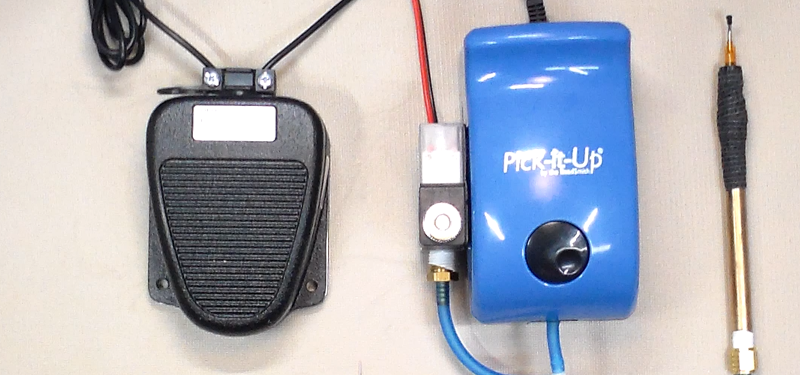We are always surprised how much useful hacking gear is in the typical craft store. You just have to think outside the box. Need a hot air gun? Think embossing tool. A soldering iron? Check the stained glass section. Magnification gear? Sewing department.
We’ve figured out that people who deal with beads use lots of fine tools and have great storage boxes. But [Dave] found out they also use vacuum pickup tweezers. He had been shopping for a set and found that one with all the features he wanted (foot pedal, adjustable air flow, and standard tips) would run about $1000.
By picking up a pump used for bead makers and adding some components, he put together a good-looking system for about $200. You can see a video of the device, below, and there are several other videos detailing the construction.
The pickup needles use the same fitting that medical syringes use–known as a Luer lock. [Dave] provides links to all the components over on Hackaday.io. The actual build is simple enough. No Arduino, ESP8266, or Raspberry Pi. Just a foot switch and a solenoid along with a collection of tubing and fittings.
We were hoping the first video would show the finished product working, but it doesn’t. You have to skip to video 7 for that, and you can find it below. If you want to build it yourself, you’ll have to pick up the 5 videos in between.
We’ve talked about raiding craft and art stores before for lots of project help. Of course, vacuum tweezers aren’t strictly necessary. We’ve also seen cheaper builds, often based on aquarium pumps, but not always.
















Hi,
this is great work!
You can do this for way less than $200 – complete purpose-designed stations are on Ebay from well under $100 and you can homebrew for maybe half that using one of the useless cheapo hand-vacuum pen tools as a handpiece and source of nozzles, and an aquiarium type pump for the vacuum.
You don’t need flow adjustment for pick-up, but you DO need a foot pedal.
The last link in the post is a cheaper version with an aquarium pump. But I still thought this was a good looking build and educational and had its own value. I had no idea crafters used air pickup.
@mikes electronic stuff
yes, of course there are many less expensive solutions for a vacuum pickup tool, but there were very specific design goals for this. i discuss in the video a number of less expensive options, but one of the primary goals was to make sure that the components could be purchased easily and the entire design could be replicated easily. as noted in the first video in the series, i specifically wanted a high quality foot pedal, i wanted a application pen that was heavy and included a luer lock, and i also wanted an adjustable vacuum pressure. this does make it a little more expensive if you are purchasing all of the components at once. a good example of this is that most of the Makers/DIY crowd will have a 12V power supply somewhere in the stash of supplies so there might not be any need to purchase one at all, but again the big key for the design and implementation was to document every single component so that the assembly process could be follow. as for the dedicated units on ebay, i did order the Aoyue 932 Vacuum Pickup Station and two others. i found all of them to suffer many of the same issues that led me to build this unit. in essence, i wanted a stationed that worked reliably well, that i could maintain easily, and most importantly, i wanted a station that i could regularly without fighting with it…
Wooooot ?
Another Dave ??????
Seriously: I recently deiscovered this channel, and there are some pretty interesting tricks in there when it comes to choose tools or accessories.
Recommended !
I got that pump for solstice! It’s quite nice and decently priced. I like the finger-hole depressurisation it comes with, but if you want a remote normally vacuumed couldn’t you semi* close the hole and make your release switch a simple hose-pinch? *With some leak so it can self pressurise. I think the tip it comes with is that syringe type, but if not, cutting up a syringe plunger is easy enough to adapt on
The problem with the finger hole pressure release is that when you flex your finger, it often moves your hand, and then the placement goes off a bit. Well, at least that how my hand works – your mileage may vary.
“The problem with the finger hole pressure release is that when you flex your finger, it often moves your hand, and then the placement goes off a bit.”
What I do to prevent that twitch – put a y-adapter in the hose at a short but comfortable distance from the part holder to provide a hole you can cover with the a finger on the hand you’re not using to place the part. There is a slight delay in part release, but you can compensate for that. I cut the leg of the plastic y-adapter perpendicular to the hose completely off and drill out the remaining hole to enlarge it, but not so much as to badly weaken the remaining y-adapter section.
I’ve done hose pinch with a wood+hinge+spring foot pedal before and it works. You’ll eventually want to upgrade to a solenoid though for reliability.